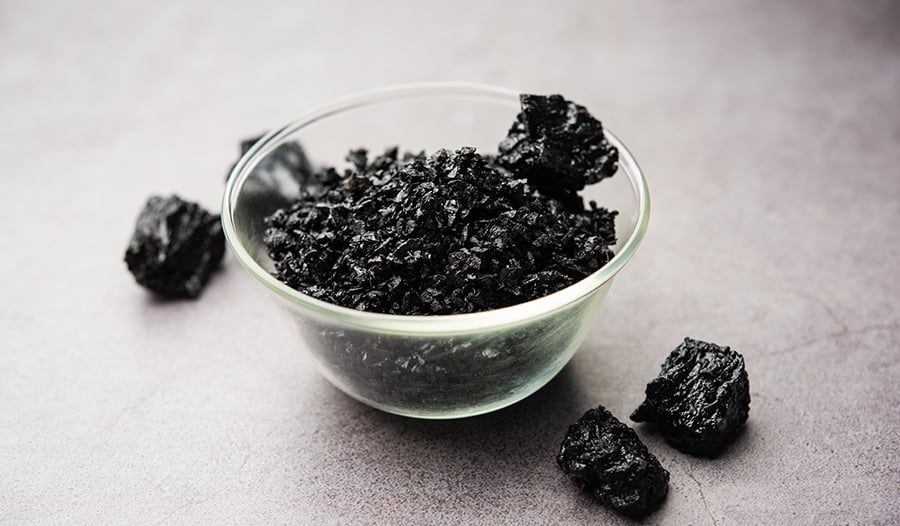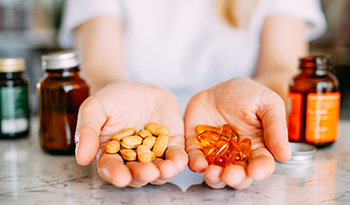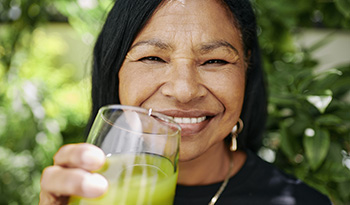Shilajit: Silný antioxidant s výhodami úľavy od stresu+ Viac

Shilajit je tajomná látka používaná tisíce rokov v starovekej kultúrnej medicíne. Aj keď tento liek hôr môže byť obklopený trochou tajomstva, moderný výskum začína osvetľovať mnohé potenciálne zdravotné výhody tejto neuveriteľnej látky.
Od pôsobenia ako antioxidant až po podporu zdravia mužov, shilajit môže byť moderným liekom hôr.
Čo je Shilajit?
Shilajit je lepkavá látka typu gumy, ktorej farba sa pohybuje od bledohnedej po tmavo hnedastú čiernu. V priebehu mája až júla sa primárne vylučuje zo skál rôznych pohorí v Indii, Rusku, Pakistane a Číne. Shilajit pochádza najčastejšie z himalájských a hindukušských pohorí.
Shilajit je zmes rastlinného aj minerálneho materiálu. Štúdie naznačujú, že vzniká, keď je organický rastlinný materiál stlačený medzi ťažkými horninami. Tvorba tejto neuveriteľnej látky sa zvyčajne vyskytuje na strmých, slnečných skalných stenách vo vysokých nadmorských výškach medzi 1 000 a 5 000 metrov nad morom. Štúdie tiež zistili, že shilajit sa s väčšou pravdepodobnosťou tvorí v skalnatých, pórovitých oblastiach, ktoré sú prirodzene bohaté na organický uhlík.
Slovo shilajit je sanskrtské slovo, ktoré znamená „dobyvateľ alebo víťaz hôr a ničiteľ slabosti“. Názov odkazuje nielen na všadeprítomnú povahu shilajitu na priehľadných skalných stenách, ale aj na jeho údajné zdravotné prínosy.
Výživový obsah Shilajit
Shilajit, používaný ako tradičná liečivá látka po stáročia v ajurvédskej medicíne, môže byť prírodným zázrakom. Môže to byť preto, že shilajit je naplnený minerálmi ako železo, horčíka zinok.
Shilajit je tiež bohatý na kyselinu fulvovú, ktorá tvorí 60 - 80% celkového zloženia látky. Kyselina fulvová je látka, o ktorej sa predpokladá, že vzniká ako vedľajší produkt rozkladu organických látok, ako je život rastlín, baktériami a hubami. Tradičné lekárske postupy v Indii naznačujú, že kyselina fulvová v shilajite môže pomôcť zlepšiť širokú škálu stavov.
Ako sa Shilajit tradične používa?
V ajurvéde, tradičnej medicíne mnohých indických kultúr, sa shilajit používa takmer ako všeliek na všetky typy stavov a ochorení. Niektoré z týchto stavov zahŕňajú poruchy trávenia, cukrovku, stavy močových ciest a imunitnú podporu.
Zatiaľ čo tradičná ajurvédska medicína oslavuje shilajit pre jeho potenciálne rôzne zdravotné prínosy, moderný výskum naznačuje, že táto látka môže skutočne mať niektoré mimoriadne vlastnosti.
Niektoré z neuveriteľných vlastností, ktoré môže mať shilajit, zahŕňajú prínos stresovej reakcie, zlepšenie únavy, zvýšenie výkonnosti a pomoc detoxikačným cestám tela.
Nižšie je uvedených 6 potenciálnych výhod shilajitu.
1. Shilajit môže prospieť stresovej reakcii
Stres je pre drvivú väčšinu jednotlivcov príliš bežnou skúsenosťou. Chronický alebo dlhodobý stres je spojený s celým radom zdravotných problémov, od porúch duševného zdravia až po kardiovaskulárne choroby. Štúdie dokonca spájajú chronický stres so zníženou imunitnou odpoveďou, zvýšeným oxidačným stresom a vyšším množstvom zápalu.
Shilajit môže pomôcť znížiť oxidačný stres a znížiť zápal v tele. Jedna štúdia dvojito zaslepená randomizovaná placebom kontrolovaná štúdia sa zamerala na suplementáciu shilajitom u žien, ktoré prešli menopauzou a trpeli osteopéniou. Osteopénia je nízka minerálna hustota kostí, ktorá môže prispieť k slabým kostiam.
Ženy v štúdii boli vo veku od 45 do 65 rokov a boli rozdelené do skupín, ktoré dostávali buď suplementáciu shilajit alebo placebo denne počas 48 týždňov. Štúdia zistila, že skupiny, ktoré doplnili shilajit, mali znížené množstvo zápalu a oxidácie, menšiu stratu kostí a vyššie množstvo glutatiónu v krvnom obehu.
Glutatión je jedným z najdôležitejších antioxidantov produkovaných telom. Štúdie na zvieratách tiež naznačujú, že shilajit môže pôsobiť ako silný antioxidant zvýšením hladín iných antioxidantov vyrobených v tele, ako je kataláza.
Treba poznamenať, že v inej štúdii na zvieratách shilajit pomohol zvýšiť oxidačný stres. Predpokladalo sa, že je to preto, že shilajit pôsobí ako regulátor imunitného systému, nielen ako stimulátor imunitného systému.
2. Shilajit môže pomôcť zlepšiť únavu
Únava je definovaná ako pocit únavy alebo únavy a všeobecný nedostatok energie. Aj keď únava môže byť krátkodobá, môže sa stať chronickou a ovplyvniť dlhodobé zdravie a pohodu.
Niektoré štúdie naznačujú, že chronická alebo dlhodobá únava môže postihnúť až 10% dospelej populácie na celom svete. Odhaduje sa tiež, že 1% svetovej populácie bojuje so syndrómom chronickej únavy.
Výskum naznačuje, že shilajit môže byť užitočný pri únave. Jedna štúdia na zvieratách zahŕňajúca model syndrómu chronickej únavy (CFS) potkanov zistila, že suplementácia shilajitom počas 3 týždňov pomohla. Štúdia tiež zistila, že doplnenie shilajitom pomohlo znížiť symptómy úzkosti, ktoré môžu byť spojené s CFS.
3. Shilajit môže pomôcť zlepšiť atletický výkon
Mnoho aktívnych jedincov môže pri tréningu naraziť na stenu kvôli únavu z výkonu. Únava z výkonu je pokles produkcie za určitý čas.
Štúdie naznačujú, že shilajit môže pomôcť zlepšiť únavu z výkonu. Jedna štúdia zahŕňajúca 63 aktívnych mladých mužov vo veku od 21 do 23 rokov študovala účinky doplnku shilajit na únavu, ku ktorej došlo počas tréningu a zníženú silu. Účastníci boli rozdelení do skupín, ktoré dostávali suplementáciu shilajit a skupiny s placebom. Po 8 týždňoch skupina, ktorá dostávala suplementáciu shilajitom, zaznamenala pokles únavy z výkonu v porovnaní s placebom.
4. Shilajit môže prospieť zdraviu mozgu
Keďže sa uskutočňuje ďalší výskum tejto fascinujúcej látky, zdá sa, že shilajit môže prospieť zdraviu mozgu. Napríklad štúdie naznačujú, že kyselina fulvová v shilajite môže pomôcť Alzheimerovej chorobe.
Alzheimerova choroba je progresívny stav, ktorý spôsobuje stratu pamäti a pokles kognície. Výskum naznačuje, že je čiastočne spôsobená zhromažďovaním určitých proteínov, ktoré narušujú a bránia komunikácii mozgových buniek.
Štúdie naznačujú, že kyselina fulvová môže pomôcť zabrániť zhromažďovaniu týchto proteínov, čo by mohlo byť prospešné pre Alzheimerovu chorobu. Výskum tiež zistil, že shilajit môže pomôcť posilňovať a zlepšovať mozgové bunky, čo vedie k lepšej komunikácii mozgových buniek. Štúdie na zvieratách zahŕňajúce shilajit a extrakt ashwagandha zistili zvýšenie kognície, ako aj lepšiu tvorbu pamäte.
5. Shilajit môže prospieť zdraviu mužov
Testosterón je primárne mužský hormón, ktorý sa považuje za zodpovedný za širokú škálu funkcií v mužskom tele. Medzi tieto funkcie patrí zvýšenie svalovej hmoty, udržiavanie svalovej sily, produkciu spermií a kontrola sexuálnej túžby.
S vekom telo prirodzene začína produkovať menej testosterónu. Štúdie naznačujú, že muži vo veku 30 rokov môžu každý rok zažívať pokles hladiny testosterónu o 2-3%.
Nízke hladiny testosterónu sú spojené s obezitou, nízkou svalovou hmotou, erektilnou dysfunkciou a dokonca aj depresiou.
Výskum naznačuje, že shilajit môže pomôcť zvýšiť hladinu testosterónu. Jedna randomizovaná, dvojito zaslepená placebom kontrolovaná štúdia sa zamerala na zdravých mužských účastníkov vo veku od 45 do 55 rokov.
Štúdia sleduje účastníkov počas 90 dní, aby zistila, ako by suplementácia shilajitom ovplyvnila hladiny testosterónu. Štúdia zistila, že skupina, ktorá dostávala suplementáciu shilajitom, mala významné zvýšenie hladín testosterónu, ako aj hladín dehydroepiandrosterónu alebo DHEA.
DHEA je hormón, ktorý telo používa na tvorbu testosterónu. Štúdie naznačujú, že užívanie DHEA môže zvýšiť použiteľné alebo biologicky dostupné hladiny testosterónu v tele.
6. Shilajit môže pomôcť zlepšiť hojenie rán
Bezpečné a efektívne hojenie rán je jedným z mnohých zázrakov ľudského tela. Rýchly a hygienický proces hojenia je potrebný, aby sa zabránilo strate krvi, ako aj akýmkoľvek infekciám.
U niektorých jedincov, ktorí trpia chorobami, ako je cukrovka, môže byť narušený proces hojenia rán. Toto poškodenie môže viesť k zvýšeniu rizika infekcií.
Výskum naznačuje, že shilajit môže pomôcť urýchliť proces hojenia rán. Jedna skúmavková štúdia zistila, že shilajit bol schopný zvýšiť rýchlosť procesu hojenia rán. Štúdia tiež zistila, že táto neuveriteľná látka bola schopná znížiť zápal, ktorý bol spojený so zranením.
ďalšia randomizovaná, dvojito zaslepená, placebom kontrolovaná štúdia zameraná na účinky shilajitu pri hojení zlomenín kostí. Štúdia sledovala 160 účastníkov vo veku od 18 do 60 rokov, ktorým bola diagnostikovaná zlomenina holennej kosti a zahŕňali 3 rôzne nemocnice. Účastníci boli zaradení buď do skupiny, ktorá dostávala suplementáciu shilajit alebo placebo počas 28 dní. Skupina, ktorá dostala suplementáciu shilajitom, bola hodnotená röntgenovým žiarením a zistilo sa, že sa hojí úplne o 24 dní rýchlejšie ako skupina s placebom.
- jedlo so sebou
Shilajit je zmes horských rastlinných aj minerálnych materiálov, ktoré sa po stáročia používajú v ajurvédskej medicíne. Moderný výskum naznačuje, že táto látka môže byť skutočne „dobyvateľom hôr a ničiteľom slabosti“ kvôli svojim potenciálnym zdravotným prínosom.
Shilajit môže ponúknuť širokú škálu výhod pre celé telo od pôsobenia ako silný antioxidant až po podporu kognície a zdravia mužov. Pridanie shilajitu do silnej zdravotnej rutiny môže byť prospešné pre celkové zdravie v budúcnosti.
Referencie:
- Agarwal SP, Khanna R, Karmarkar R, Anwer MK, Khar RK. Shilajit: recenzia. Phytother Res. 2007; 21 (5) :401-405. doi: 10.1002/ptr.2100
- Andrade V, Wong-Guerra M, Cortés N a kol. Škálovanie andského Shilajitu: Nový neuroprotektívny prostriedok pre Alzheimerovu chorobu. Farmaceutické výrobky (Bazilej). 2023; 16 (7): 960. Publikované 4. júla 2023 doi:10.3390/ph16070960
- Carrasco-Gallardo C, Guzmán L, makaróny RB. Shilajit: prírodný fytokomplex s potenciálnou prokognitívnou aktivitou. Int J Alzheimerova choroba december 2012; 2012:674142. doi:10.1155/2012/674142
- Ding R, Zhao M, Fan J a kol. Mechanizmy tvorby a exsudácie tibetskej medicíny Shilajit (Zhaxun). Chin Med. 2020; 15:65. Publikované 29. júna 2020. doi:10.1186/s13020-020-00343-9
- Keller JL, Housh TJ, Hill EC, Smith CM, Schmidt RJ, Johnson GO. Účinky suplementácie Shilajit na únavou vyvolané zníženie svalovej sily a hladín hydroxyprolínu v sére. J Int Soc Sports Nutr. 2019; 16 (1) :3. Publikované 6. februára 2019. doi:10.1186/s12970-019-0270-2
- Kim KH, Jung JH, Chung WS, Lee CH, Jang HJ. Kyselina ferulová indukuje keratín 6α inhibíciou akumulácie jadrového β-katenínu a aktiváciou Nrf2 pri zápale vyvolanom ranami. Biomedicína. 2021; 9 (5): 459. Publikované 22. apríla 2021. doi:10.3390/biomedicines9050459
- Malekzadeh G, Dashti-Rahmatabadi MH, Zanbagh S, Akhavi Mirab-bashii A. Mumijo zmierňuje chemicky indukovanú zápalovú bolesť u myší. Altern Ther Health Med. 2015; 21 (2): 42-47.
- Meena H, Pandey HK, Arya MC, Ahmed Z. Shilajit: všeliek na problémy s vysokou nadmorskou výškou. Int J Ayurveda Res. 2010; 1 (1) :37-40. doi:10.4103/0974-7788.59942
- Pandit S, Biswas S, Jana U, De RK, Mukhopadhyay SC, Biswas TK. Klinické hodnotenie purifikovaného Shilajitu na hladine testosterónu u zdravých dobrovoľníkov. Andrológia. 2016; 48 (5): 570-575. doi:10.1111/and.12482
- Extrakt Pingali U, Nutalapati C. Shilajit znižuje oxidačný stres, zápal a stratu kostí, aby sa v závislosti od dávky zachovala minerálnu hustotu kostí u postmenopauzálnych žien s osteopéniou: Randomizovaná, dvojito zaslepená, placebom kontrolovaná štúdia. Fytomedicína. 2022; 105:154334. doi:10.1016/j.phymed.2022.154334
- Sadeghi SMH, Hosseini Khameneh SM, Khodadoost M a kol. Účinnosť Momiai pri oprave zlomenín holennej kosti: Randomizovaná dvojito zaslepená placebom kontrolovaná klinická štúdia. J Altern Doplnok Med. 2020; 26 (6) :521-528. doi:10.1089/acm.2019.0453
- Salleh MR. Životná udalosť, stres a choroba. Malajčania J Med Sci. 2008; 15 (4): 9-18.
- Schliebs R, Liebmann A, Bhattacharya SK, Kumar A, Ghosal S, Bigl V. Systémové podávanie definovaných extraktov z Withania somnifera (indický ženšen) a Shilajit odlišne ovplyvňuje cholinergné, ale nie glutamatergické a GABAergné markery v mozgu potkanov. Neurochem Int. 1997; 30 (2) :181-190. doi:10.1016/s0197-0186 (96) 00025-3
- Shailesh K. Bhavsar, Aswin M. Thaker, Jitendra K. Malik, Kapitola 51 - Shilajit, Redaktor (y): Ramesh C. Gupta, Nutraceuticals, Academic Press, 2016, strany 707-716, ISBN 9780128021477, b978-0-12-802147-7.00051-6. https://www.sciencedirect.com/science/article/pii/B9780128021477000516
- Son, C.-G. (2012) „Prehľad prevalencie chronickej únavy na celom svete“, The Journal of Korean Oriental Medicine, 33 (2), s. 25—33. K dispozícii na adrese: https://www.jkom.org/upload/33-2%2003(25-33).pdf.
- Stanworth RD, Jones TH. Testosterón pre starnúceho muža; súčasné dôkazy a odporúčaná prax. Clin Interv Aging. 2008; 3 (1) :25-44. doi:10.2147/cia.s190
- Surapaneni DK, Adapa SR, Preeti K, Teja GR, Veeraragavan M, Krishnamurthy S. Shilajit zmierňuje behaviorálne príznaky syndrómu chronickej únavy moduláciou osi hypotalamus-hypofýza-nadobličky a mitochondriálnej bioenergetiky u potkanov. J Etnofarmakol. 2012; 143 (1): 91-99. doi:10.1016/j.jep.2012.06.002
- Swat M, Rybicka I, Gliszczyńska-Świdło A. Charakterizácia nápojov kyseliny fulvovej podľa minerálneho profilu a antioxidačnej kapacity. Potraviny. 2019; 8 (12): 605. Publikované 22. novembra 2019. doi:10.3390/foods8120605
- Winkler J, Ghosh S. Terapeutický potenciál kyseliny fulvovej pri chronických zápalových ochoreniach a cukrovke. J Diabetes Res. 2018; 2018:5391014. Publikované 10. septembra 2018. doi:10.1155/2018/5391014
VYHLÁSENIE: Toto Centrum zdravia a pohody neposkytuje diagnózu,...













































































 Obsah
Obsah














